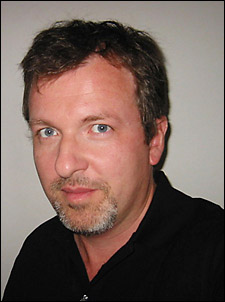Fehrenbach joins FAS as professor of history of art, architecture
Art historian Frank Fehrenbach, a prolific and expansive scholar who is one of the world’s leading intellects in the field of Renaissance art, has been named professor of the history of art and architecture in Harvard University’s Faculty of Arts and Sciences, effective July 1.

A native German, Fehrenbach, 41, is currently a visiting professor at Harvard and on a two-year research fellowship with the Fritz Thysen Stiftung in Cologne. He has also taught at leading European universities including Friedrich Schiller University in Jena, the University of Basel, and Humboldt University in Berlin, as well as the Kunsthistorisches Institut in Florence and the Max Planck Institut’s Bibliotheca Hertziana in Rome.
“Professor Fehrenbach’s studies of southern Renaissance art are substantial and learned,” says William C. Kirby, Edith and Benjamin Geisinger Professor of History and Dean of the Faculty of Arts and Sciences. “His expertise also extends well beyond Italy and into the early modern period, and will be of interest to historians of science and culture, to medievalists and early modern scholars, and to scholars of classics and philosophy. I am delighted to welcome him to our faculty.”
Well versed in the medieval, Renaissance, Baroque, and modern art of both Northern and Southern Europe, Fehrenbach has authored three books and edited two others. His early writing on Leonardo da Vinci represents a major engagement with a figure who is at once highly challenging – grounded in philosophy, biology, geology, perception, anatomy, medicine, and mechanics – yet central to the Italian Renaissance. In this work, Fehrenbach opens new windows on the well-documented interaction between da Vinci’s aesthetic and scientific interests. His broadly interdisciplinary focus on da Vinci’s studies of liveliness, movement, perception, and mechanics reveal art and science as complementary avenues through which the artist investigated the natural world.
Fehrenbach’s more recent work has concentrated on the artistic use of water in a conspicuous type of Baroque art: the public fountain. In a forthcoming book on Rome’s “Fontana dei Quattro Fiumi” (Fountain of Four Rivers) and “Fontana di Trevi” (Trevi Fountain), he draws on topography, geographical mythology, hydraulics, biology, antiquarianism, and a close reading of the fountains themselves to examine water’s symbolic, political, and theological significance. Fehrenbach shows how water is used to enliven stone statuary and how these fountains were rendered iconographically significant to their patrons.
Fehrenbach is currently completing a work on the joining of da Vinci’s science and aesthetics. He is working on a book on animation and liveliness as central concepts in early modern art and art theory. He is also collaborating on three books titled “Renaissance Tombs of Tuscany,” “Crisis and Epiphany,” and “Art and Nature in the Renaissance.”
Fehrenbach holds a master’s degree in art history, philosophy, and medieval and modern history, awarded by the University of Tübingen in 1990, and a Ph.D. received from Tübingen in 1995. He received his Habilitation, comparable to promotion to full professor, from the University of Basel in 2003. His work earned him the renowned prize of the Aby Warburg Stiftung in 2004, and his doctoral thesis was awarded the Hans Janssen Prize of the Academy of Sciences in Göttingen, Germany’s most prestigious art history honor.




